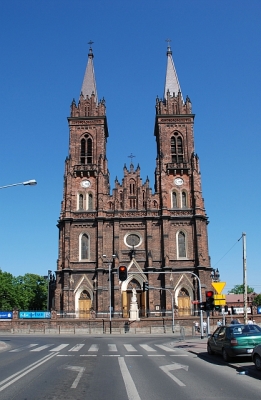For thousands of Jews who passed through the Lodz ghetto, the red brick church and the adjacent wooden footbridge crossing over Zgierska Street are recognizable symbols. The slender church towers can be seen on many photographs and pictures showing this fragment of Lodz history. Under such dramatic circumstances, the Catholic church became a part of the Jewish tragedy.
 The St. Mary's Assumption’s Church in the Old Town was built where the. first Catholic church in Lodz was originally located. The construction plans were signed in 1887, and the work commenced a year later. The old wooden church, which for generations stood at the Zgierska Street site, was transferred to the old Christian cemetery on Ogrodowa Street near the gate of Izrael Poznanski's factory. The old church is still there and is dedicated to St. Joseph.
The St. Mary's Assumption’s Church in the Old Town was built where the. first Catholic church in Lodz was originally located. The construction plans were signed in 1887, and the work commenced a year later. The old wooden church, which for generations stood at the Zgierska Street site, was transferred to the old Christian cemetery on Ogrodowa Street near the gate of Izrael Poznanski's factory. The old church is still there and is dedicated to St. Joseph.
Construction of the new church began at the square, which was already named Plac Koscielny. The neo-Gothic church was designed by architect Konstanty Wojciechowski.
It was a three-nave basilica of non-plastered red brick. This kind of church architecture was common at that time because it carried a certain Polish national pride. The facade with two towers creates a stately impression.
The church was finished in 1897. Its construction was supported by the city's industrialists and represented the unique multicultural forces that built Lodz. The Scheiblers, a Protestant family, donated 15,000 rubles; Juliusz Kunitzer, also a Protestant, gave the Catholic community 2,000 rubles. The Jewish industrialist Izrael Poznanski financed the flooring.
And thus, the first neo-Gothic church in Lodz overlooked the Old Town, an area that curiously was mostly Jewish. During the Second World War the church became a part of the ghetto. Initially, the church doors were closed. Later, the Nazis decided to turn it into a warehouse for property stolen from the Jews. From spring to autumn 1942, the clothes of the people murdered at Chelmno-nad-Nerem were brought here. When transports to the death camp were suspended, a sorting plant for feathers and down was established in the church. The Jews called it "The White Factory" in reference to Ludwik Geyer's textile factory, famous in Lodz before the war. In this case, however, they did not mean the color, but the down floating in the air.
On Saturday, following the order of the [German] authorities, working groups arrived from the outside [of the ghetto] and removed the statue of the Virgin Mary, which stood on a plinth in front of the Holiest Virgin Mary's Church at Zgierska Street, and cut down four high wooden crosses in the courtyard. Simultaneously, other groups took down the statue located at 17 Zgierska St.
The Chronicle of the Lodz Ghetto, August 17, 1942,Vol. 2,p. 211.
Today trucks were bringing various kinds of parcels with clothes, linen, etc. to the courtyard of the Holiest Virgin Mary's Church. These parcels are usually wrapped in tablecloths, sheets and other kinds of linen. They will be sorted and perhaps stored there.
The Chronicle of the Lodz. Ghetto, June 4, 1942,Vot. 2, p. 20.
The Feast of Passover (Pesach) was approaching together with the beginning of spring. The towers of the Holiest Virgin Mary's church, soaring high into the sky, were visible from the windows of our room on the third floor in the ghetto. The church bells, covered with feathers, had already been silent for years (the Germans established a feather warehouse in the church), but the birds did not leave us. They returned to us from distant lands. The barbed wires did not disturb their chirping and uniting us in our mutual misery.
Ruth Eldar, Wstrząsnąć filarami świątyni.

 Home
Home
